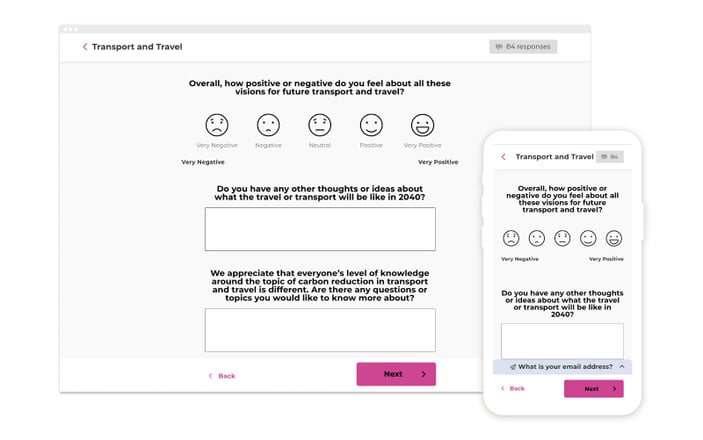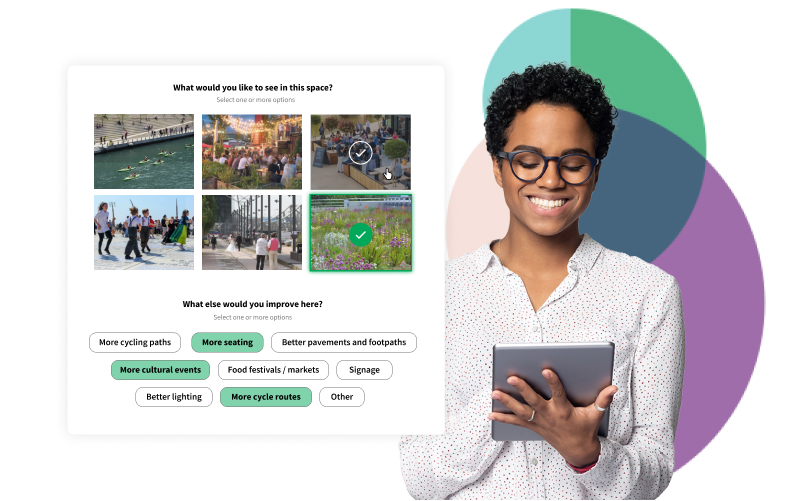How to make the most out of your community engagement surveys

By Charlotte Cooper | 15/08/22 13:45
4 min read
Surveys are one of the easiest and most effective ways to help engage a community online. Not only are you encouraging direct public participation, but they can leave you with a wealth of data that’s perfect for shaping your project.
At Commonplace, we know that neighbourhoods develop so much more successfully when opinions and priorities are shared. While surveys are a great method for doing this, it’s crucial that you craft them with care. Everything from the formatting to the questions, to the length can drastically affect the quality of answers you get. The goal of any engagement survey is… just that- engaging with people.
Done right, they can give you all sorts of insights into what the community actually wants out of your next project. When rushed or poorly constructed, you probably won’t be getting the engagement you need and you’ll be left with little to no quality data to work with.
So, how do you get more people to answer? Whatever your next project is, we’re here with your quick guide on making the most out of your next community survey.
Let’s get started!
Stay up to date with every Commonplace update by signing up to our engagement newsletter!
Community engagement surveys: the numbers
- Survey length: Did you know that the average human attention span is only 8 seconds? That’s a pretty small window to get people interested in your questions.
Think about the last time you were asked to complete a survey. How did you feel about the length of the questions or how many of them you had to answer? It’s simple. The more questions you ask, the lower your response rates. Studies show that the ideal completion rate for most surveys is 5-10 minutes, so make sure to test how long yours take to complete before sending them out. - Mobile use: In this day and age, making your digital engagement strategy mobile-friendly is an absolute must. Over 80% of Commonplace customers use a mobile. That’s a large chunk of community input you could potentially be missing out on, so make sure your platform is optimised. (Luckily, ours is!)

- Presentation: One last thing that should never be forgotten is how your survey will look. According to SurveyMonkey, ‘posts that include images produce 650% higher engagement than text-only posts.’ Not only do icons and images make your overall look more engaging, but the right pictures can help illustrate your questions and make it crystal clear what you’re talking about.

How do you choose the right questions for your community engagement survey?
Now it’s time to consider questions. These are how you’ll start a dialogue with the community, so it’s important to consider each one carefully.
- Create a mix of open and closed questions: Both open and closed questions can be used to create effective surveys, but it’s crucial you find the right mix. Closed questions are generally easier to answer and can give a wealth of quantitative data- great for sorting out priorities and crunching numbers. The effectiveness of open questions depends on how much someone wants to write but can give you rich qualitative data that’s perfect for action planning and showing how the community is feeling.
- Keep your language neutral to avoid bias: For any project, you’ll want the community’s full and honest opinion. Asking leading questions could potentially influence the answer and skew your results. For example, consider “Main Street isn’t very cycle-friendly at the moment. But what do you think?” vs “Do you feel Main Street is accessible for cyclists?” One already conveys a strong opinion, while the other opens the door for an honest response.
So how do you choose? It’s all about effective citizen participation. Open questions may give you ideas you’ve never thought of, but can they be turned into an actionable plan? It might be easier to give a finite number of options that can be implemented instead. The answers to open-ended questions can also be difficult to categorise, especially if you have a lot. Luckily, there’s now technology that can be used to identify key themes and sentiment in unstructured, free text data so you can work out the general consensus.
Experiment with different kinds of questions and don’t be afraid to test out your survey first. Remember to keep the length front of mind so the mix of questions doesn't make it too long to answer. - Alter for interest: Community engagement projects can span so many different areas, so a single survey is unlikely to cover them all. Creating a few more targeted surveys for each different area can help yield much more specific results than one broad set of questions. If you’re not sure which question will work best, we have tried and tested templates for a range of different survey types. Whether it’s Active Travel, Post Occupancy Evaluation or social value, just ask and Commonplace will provide you with a good base of starter questions.
- Keep questions optional: A community engagement survey doesn’t have to be 100% completed to be useful. Some questions people may not understand or not feel like answering and forcing people to do so could make them more likely to quit. A few answers given is more data than none, so consider carefully which questions you’d like to make mandatory.
- Blend online and offline surveys: At Commonplace, we always recommend a blended approach. If some people aren’t able to answer your questions digitally, offer them a paper survey instead. This lets the more digitally illiterate be part of the conversation and, with us, you can easily add these results to the rest of your data to keep everything in one place.
- Brand yourself: Not only should a community engagement survey be visually appealing, but it should match your branding down to a T. It’s part of your online presence after all and adding your own corporate branding could help raise responses by up to 10%!
Ready to gather some insights? Simply get in touch and we’ll be more than happy to demonstrate how Commonplace can take your community engagement surveys to the next level.
Organise a free personalised demo of the Commonplace platform.

